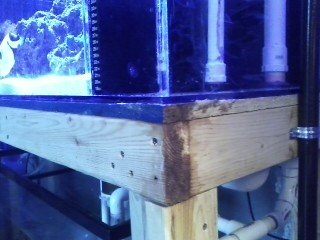Floyd,
What size and how many bulkheads do you use? How do you figure out the internal/external box dimensions? I'm sure there is some calculation that can be done based on flow rate and/or overflow box size, but I haven't run across it...my particular setup will target about 1500-ish GPH and is a 48" with an internal full C2C (or close).
Thanks!
Actually I was having an interesting conversation with Bean about that recently.
Basically what I have been doing is allowing for the footprint dims to allow for 1/2" of clear space from the edge of the drain bulkheads to the inside edge of the box.
Then, the height of the box is driven by how deep the pass-through bulkheads need to be in order to keep them fully submerged during operation. Usually this is not an issue as you generally want the top of the outer box to be roughly lining up with the top of the tank. The factor here to consider is which is worse: the tank overflowing, or the box overflowing, in the event of a total failure (2 pipes clogged and third cannot handle flow, or all 3 pipe clogged).
The one in the pic, I made so that the outer box is actually even with the bottom edge of the trim on the tank. So the outer box is lower than the rim of the tank. What I have realized since is that in a bad scenario where the drains can't keep up, and then let's say you have a sensor that shuts off the return pump when the water level in the external box rises to a certain point, or it overflows. What happens in this situation is that (let's say it's a total block of all 3 drains) the external box will continue to overflow until the water level in the tank drops such that it is below the level of the external box, or reaches the bottom of the weir or notches (in a notched overflow). Because of this, I now make these so that the external box stands off the tank so that it can be installed even with the rim of the tank by adding a laminated sheet of 1/4" material to that side of the external box.
Then, you have plenty of "overhead" for your emergency to kick in full and siphon & flush as the box level oscillates.
Increasing the footprint dim of the external box will give you extra volume to allow for the time factor in which the box fills up to a critical point. This turns out to be a bit of a complex calculation, because you have to figure out
1) how fast the water level rises based on the footprint of the box and in influx of water,
2) how long it takes for the emergency to turn into a full siphon (which depends heavily on your pipe routing, which is why it's important to have no 90s and a straight shot to the sump)
3) what water level you need in order to cause the emergency pipe to turn into a full siphon with no air intrusion from the surface (vortexing)
4) what the full-siphon capacity of the emergency pipe is
Usually, the only time this becomes an issue is when you are pushing 3000 GPH or better. 1.5" emergency pipe with a straight shot to the sump (or maybe just a few 45s) will siphon pretty quick once the water over it reaches about 1" or so, so you just have to allow for the rate of rise of water that gets it to this point and allow for a comfortable overage.
At 1500 GPH, if you have 2" of headroom from the top of the emergency pipe to the top of the box and it's a 1.5" pipe - in reality, no worries, not at all.

